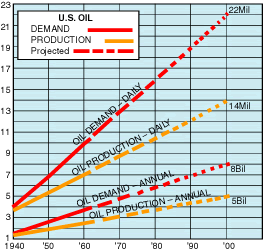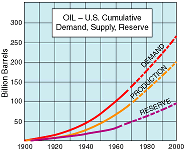Has Production Peaked?Bulls and Bears Duel Over SupplyFrom the May 2000 edition of The Explorer, magazine of the American Association of Petroleum Geologists. Author: David Brown |
|
|
These are the oft-cited charts A.I. Levorsen used in his February 1964 AAPG BULLETIN article, "Big Geology for Big Needs." Levorsen's projected demand numbers for the year 2000 proved to be remarkably accurate -- but the supply expectations have fallen far short of the current reality.
|
The world is running out of crude oil. No, it isn't. And there you have the two sides of a simmering controversy in petroleum geology and the oil industry in general. Do the pessimists have a point? In his paper "Big Geology for Big Needs," published in the February 1964 AAPG BULLETIN, A.I. Levorsen projected total United States oil demand of 22 million barrels per day in 2000, with U.S. oil supply of 14 million barrels per day (see figures, left). Levorsen's demand number appears remarkably accurate, only slightly higher than current forecasts. But his supply number contrasts sharply with average 1999 U.S. oil production of just over 5.9 million barrels per day. The difference? Levorsen expected a much higher rate of oil discovery during the past 35 years, and anticipated a much lower level of imports. Supply pessimists take the industry's declining oil discovery rate as an alarm signal, portending a crisis on the near horizon. Most believe world oil production will peak within a decade -- if it hasn't already. "The peak of production will be a more important occurrence than any other event in human history, affecting more people, in more places," said AAPG member Walter Youngquist, a leading proponent of the scarcity theory. Youngquist is one of a small, persistent group of geologists seeking public and government awareness of this view. L.F. "Buzz" Ivanhoe calls them the Cassandras, after the mythological Trojan princess who could foretell the future but was doomed never to be believed. |
|
"There are a number of us who are petroleum geologists, upstream petroleum professionals. We're all retired, so we can say what we want to," Youngquist said. These geoscientists offer several points about the outlook for the world's future oil supply:
Cassandras CrossingIvanhoe said he began his career as a mining engineer in Ecuador, then returned to the United States and earned a degree in geology at Stanford University. He worked for Chevron (at that time Standard Oil of California), and later Occidental Petroleum. Today Ivanhoe lives in Ojai, Calif., but serves by long-distance as director of the M. King Hubbert Center for Petroleum Studies at the Colorado School of Mines. The center publishes a quarterly newsletter on the oil-supply outlook, aimed at national legislators and other decision makers. "At the Hubbert Center we try to get people who know what they're doing, and take their work and reduce it to what I call the 'sports page' level of writing," he said. "For a technical person, that can be hard to do. "I don't expect any Congressmen to read it, but I hope their aides read it and save it in a file. Then when things change, they'll have all the material on hand." If the supply pessimists have a guiding spirit, it surely is the ghost of King Hubbert. A widely known and respected Amerada and later Shell Oil geoscientist, Hubbert developed a model for the production lifespan of a finite, nonrenewable resource -- the famous "Hubbert curve." Hubbert first predicted in 1948 that worldwide supplies of oil were limited and that the United States would run short of oil in the 1970s, making the nation dependent on non-U.S. oil. He repeated his warning in 1956, 1962 and 1967. He later became a research geophysicist with the U.S. Geological Survey and also taught at Stanford University, retiring in 1976. He died in 1989 at the age of 86. Hubbert applied this bell-shaped curve to U.S. oil production in 1956 and predicted that domestic supply would begin to decline at the end of the 1960s. Production in the Lower 48 states did peak about 1970 and has declined ever since. The pessimists take a similar approach to predicting the rise and eventual decline of world oil production. For the most part, they foresee a world production peak sometime in the next 10 years. "The peak in (world oil) finding was back in the 1960s, and if you go on finding one barrel for every four barrels you produce, pretty soon you're out of business," Ivanhoe said. "The critical factor for production is the giant fields and the super-giant fields," he added. "They were found many years ago and they are still going strong." But, he added, we aren't finding them anymore. Declining TrendsColin J. Campbell writes and lectures extensively on the oil-supply outlook, and he may be the world's best-known advocate of the declining-production theory. (See President's Column, page 3, EXPLORER May 2000.) Campbell said he began his career with Texaco in Trinidad after earning a degree in geology at Oxford University "about 100 years ago." Actually, he's been an AAPG member since 1959. After joining British Petroleum, and then Amoco, Campbell said he ended his industry career as executive vice president for Fina in Norway. Today he lives in Ballydehob, County Cork, Ireland. In 1998, Campbell and Jean H. Laherrere, a former Total explorationist, wrote an article titled "The End of Cheap Oil" for Scientific American magazine. Some readers thought the article implied the end of oil -- a viewpoint Campbell disclaims. "Many people ask, 'When does the oil run out?' This really isn't the question, because the tail end of depletion goes on forever," Campbell said. "It becomes sort of irrelevant whether you have a few barrels around or not." In their article, Campbell and Laherrere wrote: "About 80 percent of the oil produced today flows from fields that were found before 1973, and the great majority of them are declining." Youngquist, this year's AAPG's Journalism Award winner, said new exploration tools haven't improved the oil discovery rate, even though today's tools and techniques are much improved from earlier decades. Even advanced seismic hasn't aided the hunt for giant fields, he added. "It really isn't like it's making a difference, and I'm well acquainted with 3-D and 4-D seismic," he said. "If you look at 4-D seismic, it even makes it possible to produce oil faster, so you hit a peak sooner." Supply skeptics doubt the usefulness of forecasts based on reserve totals reported by countries and companies. Those reserve numbers are almost always manipulated and may be wildly inaccurate, they say. "The former Soviet states are still reporting the same amount of oil reserves they had 10 years ago. China is reporting the same amount as 10 years ago," Ivanhoe said. "It's ridiculous." Campbell sees a more complex picture, with some countries overestimating reserves while most companies underestimate reserves. "In the case of the U.K. you have under-reporting, then you go back to OPEC where you had over-reporting back in the 1980s for quota reasons," he observed. "Companies have consistently under-reported their reserves of oil. This is no conspiracy -- it's done for sound business reasons." He believes the United States tends to overstate its oil reserves, and the world's reserves, to downplay the threat of OPEC market control. OPEC countries also tend to overstate their oil holdings for political and economic reasons, he said. Also, Campbell objects to the practice of adding field-growth numbers to current discoveries, or using them as a basis for supply projections. The U.S. Geological Survey, which received input from the AAPG Committee on Resource Evaluation, announced it will include field-growth estimates in its new "World Petroleum Assessment 2000." "Of course, it's a very political issue for them," Campbell said of the USGS. "They've taken the U.S. experience and added it not only to the world's reserves today, but also to anything that's discovered in the future. That's absolutely wrong." Future Shock?Youngquist said he received a doctorate in geology from the University of Iowa and spent most of his industry career with Exxon, first in Peru and then in the United States. He taught geology at the University of Oregon in Eugene, where he still lives, and later served as a consultant with Exxon, Amoco and Shell. After studying alternate oil sources, he's concluded they can do little to offset a decline in production of traditional oil. "Basically, the problem comes when you go from flowing oil or pumping oil to mining the stuff," he said. "To produce any real quantities of oil from these sources just isn't in the cards, I think." However, Youngquist conceded that oil sands production "will help, especially in Canada, where they're in a pretty good situation." The future rate of production may be dictated by a combination of economic, environmental and engineering factors. "The issue is primarily the rate of extraction, which is partly economic, with some environmental questions there," Campbell said. "As of today, only the most favorable deposits have been exploited," he continued, "but the question is, when you go down 75 meters or 150 meters, how economic will it be?" For the immediate future, Campbell sees OPEC's share of world oil production possibly rising to 35 percent next year. It will ultimately reach 50 percent, at which point OPEC's own production will decline, he predicted. "At a certain point, and nobody is sure where it will be, this growth in share is translated into control of price," he said. "Then there's a price shock, which will curb demand." Youngquist expects governments to begin rationing oil as supply deteriorates. "What will happen is that price will move oil to its highest and best use," he said. "People ask, 'How long will oil last?' That's inconsequential. When the peak occurs, you have a continuing world oil crisis." Levorsen's 1964 paper did not attempt to predict U.S. oil supply and demand in 2000. It simply used a projection to show what kind of exploration success the U.S. would need to maintain an oil supply about 50 percent from primary production, 25-30 percent from enhanced recovery and 15-20 percent from imports. As the title implied, Levorsen thought big oil needs would require Big Geology. In his paper he wrote these words about himself and his fellow petroleum geologists: "If we cannot discover new oil, competitively, we will go the way of the dinosaurs." Back to Oil DepletionBack to Gulland Associates Inc. |
|

